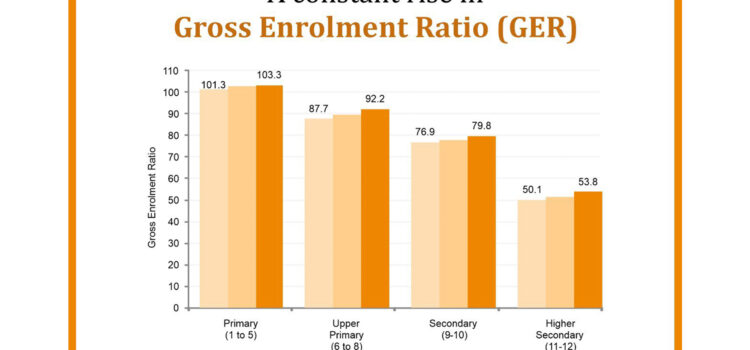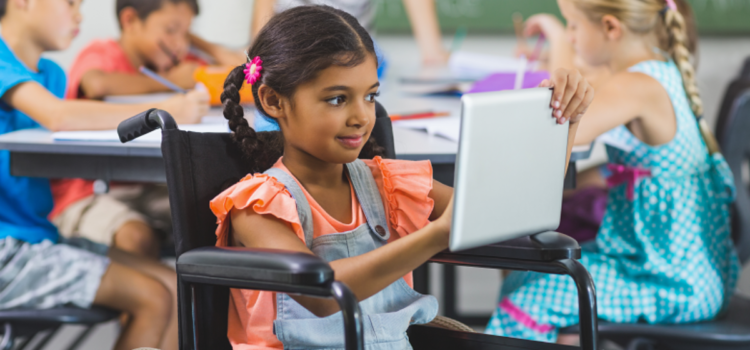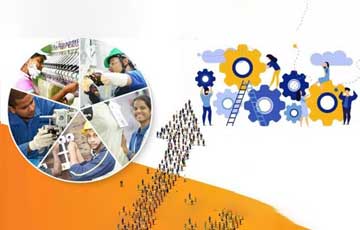Education, the bedrock of progress, empowers individuals and nations alike. In India, a country with a young and burgeoning population, ensuring equitable access to education is crucial for its future. In the labyrinth of educational metrics, the Gross Enrolment Ratio (GER) stands as a beacon, illuminating the path to universal access. The Gross Enrolment Ratio serves as a vital tool in this endeavor, offering a snapshot of educational access across different levels – primary, secondary, and tertiary. But is GER enough? Let’s embark on a journey to understand the complexities of education in India through the lens of GER.
This statistical measure, adopted globally, encapsulates a nation’s commitment to providing education for all, transcending age barriers and socioeconomic divides. As India navigates its journey towards becoming a knowledge superpower, the GER emerges as a crucial barometer, offering insights into the nation’s educational landscape and its unwavering pursuit of inclusive learning.
Unveiling the GER: A Statistical Compass
The Gross Enrolment Ratio, a brainchild of the education world, is a statistical measure that gauges student participation in a specific educational level. It’s calculated by taking the total enrolment (regardless of age) and dividing it by the official age-corresponding population for that level, expressed as a percentage. This seemingly simple formula yields valuable insights. A high GER signifies a high degree of participation, even if students are enrolled early, late, or repeat grades, pushing the figure beyond 100%. At its core, the GER is a simple yet profound calculation: the ratio of total enrolment at a specific level of education to the corresponding age group population, expressed as a percentage.
However, this seemingly straightforward metric holds the power to unveil a multitude of narratives, each one weaving India’s educational fabric. A GER value approaching or exceeding 100% signifies a nation’s ability to provide sufficient educational capacity for its entire population, a milestone that India continues to strive towards. Conversely, lower GER values indicate gaps in access, serving as a clarion call for policymakers to address the barriers that impede equitable education.
Indicator of College Enrolment Shows Increase, But Gender Gap Persists
The Gross Enrolment Ratio tracks what share of 18-23 year olds are enrolled in higher education. There’s good news: from 2016-17 to 2020-21, the GER has risen from 24.1% to 27.3%, meaning more young people are going to college. However, there’s a catch. Consistently, women have a lower Gross Enrolment Ratio than men. In 2020-21, the gap was 1.2 percentage points. While both genders saw increases (males: 24.3% to 26.7%, females: 23.8% to 27.9%), women continue to lag behind men in college enrolment.
Here’s where the power of GER lies:
Level Playing Field: Gross Enrolment Ratio facilitates the comparison of educational access across various levels – primary, secondary, and higher education. This allows policymakers to identify areas needing greater focus.
Capacity Check: GER acts as a barometer for the education system’s capacity to accommodate students of all ages. A high Gross Enrolment Ratio might indicate a need for infrastructure expansion.
Global Benchmarking: By comparing Gross Enrolment Ratio with other countries, India can track its progress in widening educational access and identify areas for improvement.
Reaching the Finish Line: A Gross Enrolment Ratio approaching or exceeding 100% is a positive sign, suggesting the nation has the capacity to educate the entire population at that level. However, it’s crucial to remember that GER doesn’t guarantee everyone completes their education.
Beyond the Numbers: Limitations of GER
While GER is a valuable tool, it’s essential to acknowledge its limitations. It’s a snapshot, not a comprehensive picture. Here’s why we need to look beyond the numbers:
Completion Counts: Gross Enrolment Ratio doesn’t tell us if students actually complete their education. High enrolment doesn’t equate to high graduation rates. Early dropouts remain a concern, especially among marginalized communities.
Quality Conundrum: GER is silent on the quality of education. Students might be enrolled, but are they learning effectively? This aspect requires further investigation.
The Indian Context: A Story of Triumphs and Challenges
India has made significant strides in education. The Gross Enrolment Ratio has steadily increased across all levels, indicating a growing commitment to education.
Primary Education: A Stepping Stone
At the primary level, India has witnessed a remarkable increase in GER, nearing universal enrolment. This signifies a significant achievement in providing basic education to a vast population. However, challenges like quality disparity and ensuring completion for all remain.
As per the World Bank’s data repository, India’s Gross Enrolment Ratio at the primary level stands at an impressive 102.8% as of 2020, a testament to the nation’s commitment to universal primary education. This achievement, however, is not without its challenges, as disparities persist across states, genders, and socioeconomic strata.
Secondary Education: Bridging the Gap
Secondary education is where the focus intensifies. While the Gross Enrolment Ratio has improved, the gap between rural and urban areas persists. Bridging this digital divide and improving infrastructure in rural areas are crucial steps.
At the secondary level, India’s GER of 77.9% in 2020 paints a more nuanced picture. While progress has been made, the nation grapples with issues of dropout rates, quality of education, and access to secondary schooling, particularly in rural and marginalized communities.
Higher Education: Scaling the Summit
Higher education presents a different set of challenges. The Gross Enrolment Ratio here is lower compared to primary and secondary levels. Expanding access to affordable and quality higher education, especially for disadvantaged groups, is essential.
The tertiary education landscape presents its own set of complexities, with India’s Gross Enrolment Ratio of 28.6% in 2020 reflecting the need for concerted efforts to expand access to higher education and address the growing demand for skilled professionals.
Beyond the Numbers: Contextualizing the GER
While the GER serves as a powerful tool for assessing educational access, it is crucial to contextualize its implications within the broader socioeconomic and cultural fabric of India. Factors such as poverty, gender inequality, infrastructure gaps, and societal norms can profoundly impact enrolment rates, underscoring the need for a holistic approach to educational reform.
Furthermore, the Gross Enrolment Ratio does not account for the quality of education or the age-appropriate enrolment of students, leaving room for further analysis and complementary metrics to paint a comprehensive picture of India’s educational landscape.
The Road Ahead: Beyond the GER
While GER provides a valuable starting point, policymakers and educators must delve deeper. Here’s what’s needed:
Quality Focus: Alongside Gross Enrolment Ratio, metrics to assess the quality of education are vital. Regular learning assessments and improved teaching methodologies are crucial.
Equity Imperative: Ensuring equitable access for all, especially girls and marginalized communities, requires targeted interventions and scholarship programs.
Skilling for the Future: The education system needs to adapt to equip students with the skills required for the 21st-century job market.
Recognizing the importance of inclusive education, the Indian government has implemented various initiatives to boost enrolment rates and ensure equitable access. Schemes like the Sarva Shiksha Abhiyan (Education for All Movement), the Rashtriya Madhyamik Shiksha Abhiyan (National Mission for Secondary Education), and the Samagra Shiksha Abhiyan (Integrated Scheme for School Education) have contributed to improving educational infrastructure, enhancing teacher training, and providing financial assistance to students from disadvantaged backgrounds.
Additionally, the National Education Policy 2020 has set ambitious targets for increasing the Gross Enrolment Ratio across all levels of education, reflecting India’s commitment to transforming its educational ecosystem and nurturing a knowledge-based society. To get more students into colleges and universities by 2035 (reaching a 50% enrolment rate), the policy needs a two-pronged approach: improving K-12 education and making higher education more accessible.
Towards a Holistic Vision: Complementing the GER
While the GER remains an indispensable tool for measuring educational access, it is imperative to complement its insights with a holistic understanding of the educational landscape. Factors such as learning outcomes, teacher-student ratios, infrastructure quality, and socioeconomic disparities must be accounted for to craft targeted interventions and foster an environment conducive to quality education for all.
By leveraging the Gross Enrolment Ratio in tandem with other educational indicators, policymakers can craft comprehensive strategies that not only increase enrolment but also ensure the delivery of high-quality education, empowering India’s youth with the knowledge and skills to thrive in an increasingly competitive global landscape.
India’s Gross Enrolment Ratio has been on the rise over the years. It increased from 23.7 percent in 2014-15 to 28.4 percent in 2021-22. When compared across states and UTs, Chandigarh leads the pack with a GER of 64.8 percent. Following closely are Puducherry at 61.5 percent and Delhi at 49 percent. Other states performing well include Himachal Pradesh (43.1 percent), Uttarakhand (41.8 percent), Kerala (41.3 percent), and Telangana (40 percent).
A Gateway to Empowerment
In the basket of India’s educational narrative, the Gross Enrolment Ratio serves as a critical thread, weaving together the aspirations of a nation committed to empowering its people through knowledge. As India continues to stride forward, the GER will remain a guiding light, illuminating the path towards universal access and equitable education.
However, the true measure of success lies not solely in the numbers but in the transformative impact of education on individuals, communities, and the nation as a whole. By embracing the insights offered by the Gross Enrolment Ratio and complementing them with a comprehensive approach, India can pave the way for a future where quality education is not a privilege but a fundamental right, empowering its citizens to unlock their full potential and contribute to the nation’s growth and prosperity.
Education is a collective endeavor, requiring collaboration between the government, educators, communities, and parents. By acknowledging the limitations of Gross Enrolment Ratio and focusing on quality, equity, and skill development, India can ensure that education empowers not just individuals, but the nation as a whole. The journey towards educational excellence has begun, and by going beyond the GER, India can unlock its true potential.



